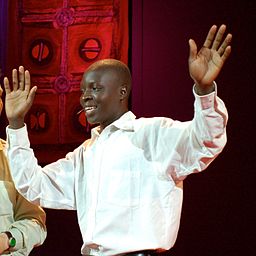1.Prologue
The other day I had the honor to interview Malawian inventor William Kamkwamba for the English-language learning show I’m on, SNS Eigojutsu on NHK E-Tele. In this article I will write about The Boy Who Harnessed the Wind—the movie based on his life—and my wardrobe for the interview.
2.About The Boy Who Harnessed the Wind
Kamkwamba grew up brimming with curiosity, taking apart radios and trying to figure out how they worked. However, droughts and famine brought hard times upon his family, and unable to pay his school tuition, he had no choice but to drop out of school. Nevertheless, he continued his studies at the village library, where he would come across a book on wind power generation. Hoping to address the lack of electricity throughout the country, Kamkwamba built a windmill using blue gum trees, bicycle parts, and other scavenged materials when he was 14 years old. The wind turbine was able to power multiple electrical appliances at his family’s house.
Kamkwamba was invited by a TED conference director to talk at TEDGlobal 2007 in Arusha, Tanzania.
His appearance on the TED stage moved the audience, and resulted in several venture capitalists in the audience pledging to help finance his education. His story was also covered by The Wall Street Journal, and subsequently picked up by media outlets around the world. Kamkwamba went on to receive a scholarship to attend the African Leadership Academy, and later studied environmental studies at Dartmouth College in the U.S.
Kamkwamba’s remarkable story was turned into a 2010 book called The Boy Who Harnessed the Wind, co-authored with journalist Bryan Mealer. That book has now been adapted into a feature film, which hits Japanese theaters starting August 2nd, 2019. Kamkwamba was in Japan to promote the film.
Here is video of Kamkwamba’s second appearance on a TED stage: https://www.ted.com/talks/william_kamkwamba_how_i_harnessed_the_wind?language=ja
3.William Kamkwamba Profile
William Kamkwamba (1987年-) is an inventor from Malawi. He constructed a wind turbine when he was 14 using blue gum trees and bicycle parts. He subsequently erected several more wind turbines and also built a solar-powered water pump that supplies the first drinking water in his village. In 2013, TIME magazine named him one of the “30 People Under 30 Changing the World". He is currently in the process of setting up an innovation center in Malawi to support enterprising young Malawians.
The Boy Who Harnessed the Wind
by William Kamkwamba and Brian Mealer
Kamkwamba’s memoir, a remarkable tale of ingenuity and perseverance, was published in 2010.
The Boy Who Harnessed the Wind
directed by Chiwetel Ejiofor
This British drama is the film adaptation of Kamkwamba’s autobiography. The film was shot in Malawi, where the story took place, and the non-Malawian members of the cast learned Chichewa, the native language.
正式HP: https://longride.jp/kaze/
4.Looking Beyond the Immediate Future
On my way to the location where this interview was to be conducted, there was a minuteslong train delay, which sent me into a light panic. I looked impatiently at my watch, and then at the schedule of departure times hanging above the train platform, and then back at my watch again.
Advances in internet tech and the ubiquity of social media have made our lives much more streamlined and convenient, but as a result, the slightest hiccup can throw us off our game—and sometimes, completely derail us. We have been conditioned to think only of the immediate future, and prioritize pleasure and comfort in everything that we do. There are convenience stores and soda machines on every urban corner, and more recently same-day deliveries have become the norm.
With all that in mind, I wanted to ask Kamkwamba why he was able to live with considerably more foresight. Despite the fact that he and his family were suffering from drought and famine, despite the fact that he was forced to drop out of school, he had the wisdom to continue his own education in any way that he could. It was through those studies that he would get the idea to build a wind turbine.
When I asked him, “Where did your spiritual strength and passion for education come from?” he answered that he had been greatly inspired by his grandmother. He said that his grandmother was the kind of strong woman who wouldn’t take no for an answer, who stacked the very bricks that would become the house he lived in. She instilled in him self-belief and the habit of setting high goals for himself. She told him, “If your clothes caught on fire, you would not wait for someone to come along and extinguish it for you.” He learned that in times of need, he had to take action.
He also gave the following analogy: “Teach a man to fish rather than give a man a fish.” This is a more pithy version of the aphorism “Give a man a fish and you feed him for a day; show him how to catch fish and you feed him for a lifetime”.
The interview reminded me of the importance of self-assessment. Are my actions merely attempts to get myself a fish for the day? Or do they serve a more long-term purpose—one that will help feed me for the rest of my life? The analogy is applicable to every aspect of our lives, whether it be education or self-improvement, or how we use computers and the internet. For students: do your studies mostly consist of rote memorization, or are you learning the lifelong skill of how to learn? If you’re out in the workforce: are you using your computer and smartphone, or are your computer and smartphone using you? Whether you live in a developing nation with no access to electricity, or a materially wealthy developed nation, where you’ll be in five or ten years all comes down to awareness.
5.My Wardrobe for the Interview
Navy necktie by Steve Bennett

Brown suit by GlobalStyle









